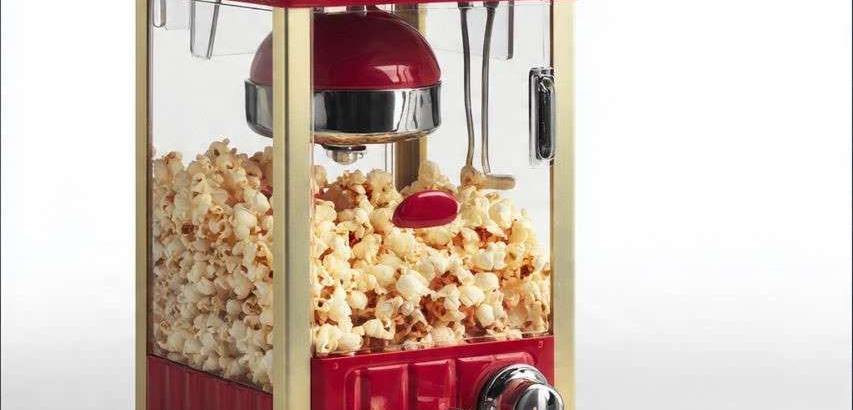A Popcorn Machine, also known as a popcorn popper, is an appliance designed specifically to pop popcorn kernels efficiently and consistently. From simple stovetop pots to large, iconic commercial carts, these machines transform hard, inedible kernels into light, fluffy snacks through the application of heat.
The Core Principle: How Popcorn Pops
Every popcorn machine, regardless of type, operates on the same fundamental scientific principle:
Moisture Inside the Kernel: Each popcorn kernel contains a small amount of water stored in a starchy endosperm.
Heating: As the kernel is heated, the water turns into steam, and pressure builds inside the kernel's hard, moisture-proof shell (the pericarp).
The "Pop": When the internal pressure reaches approximately 135 psi (9 atmospheres) and the temperature reaches around 180°C (356°F), the pericarp ruptures catastrophically.
Expansion: The superheated steam rapidly expands, causing the starchy endosperm to inflate, cool, and solidify into the familiar white, fluffy shape we know as popcorn.
Types of Popcorn Machines
Commercial Popcorn Machines
These are the large, stainless-steel machines seen in movie theaters, concession stands, and fairs. They are built for high volume, durability, and continuous operation.
Key Components:
Kettle: A large, seasoned aluminum or stainless-steel stirring pot. It is heated by an electric element or a gas burner from below.
Agitator: A mechanical stirring arm (often with scraper blades) that rotates inside the kettle. This ensures even heating and prevents kernels and oil from burning.
Heating System: Powerful electric or gas heating systems that bring the kettle to the perfect popping temperature quickly.
Heat Lamp: A lamp above the kettle's spout (or a separate warming bin) keeps popped popcorn warm and appetizing.
Popcorn Server/Bin: A large, clear, tempered glass bin that holds the popped popcorn, often with a hinged door for serving.
Butter Warmer/Melter: A separate heated compartment designed to melt and dispense clarified butter or butter-flavored oil.
Process: Oil and popcorn kernels are loaded into the kettle. The heated kettle and rotating agitator cook the kernels until they pop. Once popping slows, the operator tilts the kettle forward, dumping the popcorn into the serving bin below.
Home-Use Popcorn Makers
These are smaller versions designed for kitchen countertops.
Hot Air Poppers:
How They Work: A base unit with a heating element and a powerful fan. The fan forces hot air up through a chamber holding the popcorn kernels. The hot air heats the kernels until they pop, and the expanding popcorn is blown out of the chute into a waiting bowl.
Pros: Produces very low-calorie popcorn (no oil required), is generally easy to clean, and is a healthy option.
Cons: Can produce drier, less traditional-tasting popcorn and is often louder than other methods.
Stirring Machines (Countertop Kettle Style):
How They Work: These mimic a miniature commercial machine. They have a small, non-stick kettle with a built-in mechanical stirrer. Users add oil and kernels, and the machine heats and stirs them automatically.
Pros: Produces the classic "movie theater" taste and texture. More hands-off than stovetop popping.
Cons: Requires oil, and the kettle and stirrer need cleaning after each use.
Microwave Popcorn Makers:
How They Work: Typically, a plastic or silicone bowl with a vented lid. Users add their own kernels and optional oil. The microwave heats the kernels, and the steam escapes through the vents.
Pros: Very quick, convenient, and easy to clean. Allows for control over ingredients, unlike pre-packaged microwave popcorn bags.
Cons: Results can be less consistent, and it may not produce as many popped kernels as other methods.
Basic, Non-Machine Methods
Stovetop Pot (Whirley Pop): A specialized pot with a hand-cranked agitator for stirring kernels in oil over a burner. Highly effective and produces excellent flavor.
Simple Pot with Lid: A heavy-bottomed pot with a lid. Requires manual shaking to prevent burning.
Key Features and Considerations
Popping Capacity: Measured in ounces of unpopped kernels per batch. Commercial machines can handle 8-20 oz batches, while home machines typically manage 2-6 oz.
Power Source: Commercial machines use 120V/240V AC or natural gas/propane. Home machines are almost exclusively electric.
Materials:
Kettles: Seasoned aluminum (for commercial taste), stainless steel, or non-stick coatings.
Housings: Stainless steel (commercial) or plastic (home models).
Oil vs. Oil-Less Popping: This is the primary divide between kettle/stirring machines (which use oil for heat transfer and flavor) and hot-air poppers (which require no oil).
Warming/Storage: Commercial and some high-end home machines have warming decks or bins to keep popcorn fresh for longer periods.
The "Secret" to Theater-Style Popcorn
The distinct taste and aroma of movie theater popcorn come from a combination of factors:
Specific Kernel Type: Large, "butterfly" or "snowflake" kernels that expand to a larger, more tender size.
High-Heat Oil: The use of high-smoke-point oils, specifically coconut oil or butter-flavored coconut oil, which impart a signature flavor and aroma.
Seasoning: Flavacol is a super-fine, butter-flavored salt that is mixed with the oil and kernels in the kettle. It adheres to the popcorn perfectly, creating the classic yellow color and salty taste.
Clarified Butter Topping: The butter dispensed on top is often clarified butter, which has a richer flavor and doesn't make the popcorn soggy.
Applications Beyond Snacking
Concession Business: The primary use for commercial machines.
Event Catering: For weddings, parties, and corporate events.
Fundraising: A popular and effective tool for schools and sports teams.
Home Entertainment: Creating a theater-like experience at home.
The Popcorn Machine is a deceptively simple appliance built around a fascinating piece of food science. From the massive, gleaming machines that define the movie-going experience to the humble countertop popper in a family kitchen, its purpose remains the same: to efficiently harness heat and pressure to create a universally beloved snack. The choice of machine—whether commercial, hot-air, or stovetop—ultimately depends on the desired volume, taste, texture, and convenience, proving that this classic food has a preparation method for every preference.
 |  |  |
 |  |  |
